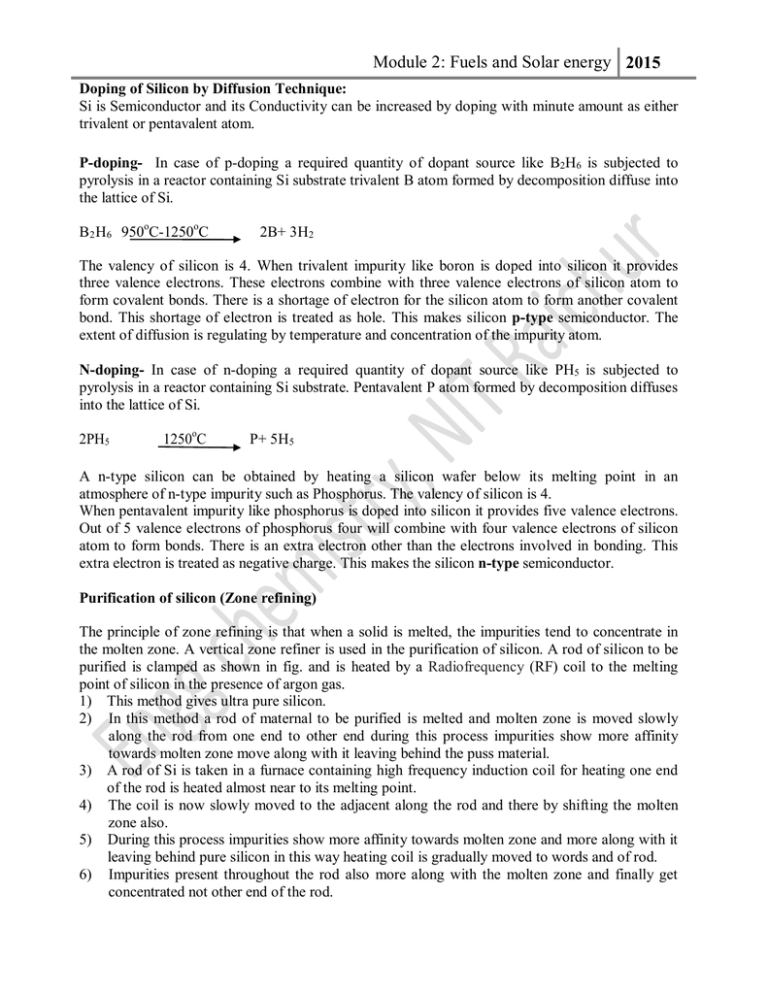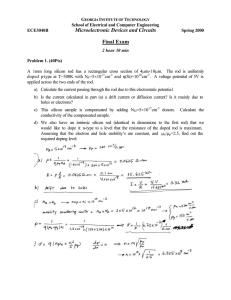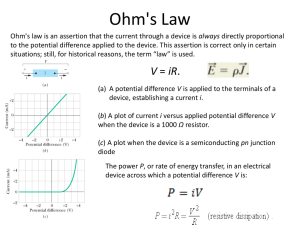Document
advertisement

Module 2: Fuels and Solar energy 2015 Doping of Silicon by Diffusion Technique: Si is Semiconductor and its Conductivity can be increased by doping with minute amount as either trivalent or pentavalent atom. P-doping- In case of p-doping a required quantity of dopant source like B2H6 is subjected to pyrolysis in a reactor containing Si substrate trivalent B atom formed by decomposition diffuse into the lattice of Si. B 2 H6 950oC-1250oC 2B+ 3H2 The valency of silicon is 4. When trivalent impurity like boron is doped into silicon it provides three valence electrons. These electrons combine with three valence electrons of silicon atom to form covalent bonds. There is a shortage of electron for the silicon atom to form another covalent bond. This shortage of electron is treated as hole. This makes silicon p-type semiconductor. The extent of diffusion is regulating by temperature and concentration of the impurity atom. N-doping- In case of n-doping a required quantity of dopant source like PH5 is subjected to pyrolysis in a reactor containing Si substrate. Pentavalent P atom formed by decomposition diffuses into the lattice of Si. 2PH5 1250oC P+ 5H5 A n-type silicon can be obtained by heating a silicon wafer below its melting point in an atmosphere of n-type impurity such as Phosphorus. The valency of silicon is 4. When pentavalent impurity like phosphorus is doped into silicon it provides five valence electrons. Out of 5 valence electrons of phosphorus four will combine with four valence electrons of silicon atom to form bonds. There is an extra electron other than the electrons involved in bonding. This extra electron is treated as negative charge. This makes the silicon n-type semiconductor. Purification of silicon (Zone refining) The principle of zone refining is that when a solid is melted, the impurities tend to concentrate in the molten zone. A vertical zone refiner is used in the purification of silicon. A rod of silicon to be purified is clamped as shown in fig. and is heated by a Radiofrequency (RF) coil to the melting point of silicon in the presence of argon gas. 1) This method gives ultra pure silicon. 2) In this method a rod of maternal to be purified is melted and molten zone is moved slowly along the rod from one end to other end during this process impurities show more affinity towards molten zone move along with it leaving behind the puss material. 3) A rod of Si is taken in a furnace containing high frequency induction coil for heating one end of the rod is heated almost near to its melting point. 4) The coil is now slowly moved to the adjacent along the rod and there by shifting the molten zone also. 5) During this process impurities show more affinity towards molten zone and more along with it leaving behind pure silicon in this way heating coil is gradually moved to words and of rod. 6) Impurities present throughout the rod also more along with the molten zone and finally get concentrated not other end of the rod. Module 2: Fuels and Solar energy 2015 7) The process is repeated several times and finally the end of rod where impurities have collected in cut off remaining part of the rod containing Si with almost 100% purity. Fig :Zone Refining


